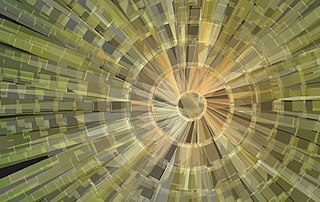 W
WAlgorithmic art or algorithm art is art, mostly visual art, in which the design is generated by an algorithm. Algorithmic artists are sometimes called algorists.
 W
WThe Alphabet Synthesis Machine (2002) is a work of interactive art which makes use of genetic algorithms to "evolve" a set of glyphs similar in appearance to a real-world alphabet. Users create initial glyphs and the program takes over. As the creators of the project put it, their goal was "to bring about the specific feeling of semi-sense one experiences when one recognizes—- but cannot read—- the unfamiliar writing of another culture." The project was developed by Golan Levin, a new-media artist, in collaboration with Cassidy Curtis and Jonathan Feinberg.
 W
WArs Electronica Linz GmbH is an Austrian cultural, educational and scientific institute active in the field of new media art, founded in Linz in 1979. It is based at the Ars Electronica Center (AEC), which houses the Museum of the Future, in the city of Linz. Ars Electronica's activities focus on the interlinkages between art, technology and society. It runs an annual festival, and manages a multidisciplinary media arts R&D facility known as the Futurelab. It also confers the Prix Ars Electronica awards.
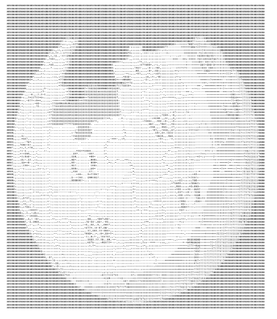 W
WASCII art is a graphic design technique that uses computers for presentation and consists of pictures pieced together from the 95 printable characters defined by the ASCII Standard from 1963 and ASCII compliant character sets with proprietary extended characters. The term is also loosely used to refer to text based visual art in general. ASCII art can be created with any text editor, and is often used with free-form languages. Most examples of ASCII art require a fixed-width font such as Courier for presentation.
 W
WComputational photography refers to digital image capture and processing techniques that use digital computation instead of optical processes. Computational photography can improve the capabilities of a camera, or introduce features that were not possible at all with film based photography, or reduce the cost or size of camera elements. Examples of computational photography include in-camera computation of digital panoramas, high-dynamic-range images, and light field cameras. Light field cameras use novel optical elements to capture three dimensional scene information which can then be used to produce 3D images, enhanced depth-of-field, and selective de-focusing. Enhanced depth-of-field reduces the need for mechanical focusing systems. All of these features use computational imaging techniques.
 W
WCyberArts International was a series of conferences dealing with emerging technologies that took place during years 1990, 1991, and 1992 in Los Angeles and Pasadena, California. The gatherings brought together artists and developers in all types of new media, including software engineers, electronic musicians, and graphic artists to explore what was a new field at the time, digital media collaborations.
 W
WThe demoscene is an international computer art subculture focused on producing demos: self-contained, sometimes extremely small, computer programs that produce audio-visual presentations. The purpose of a demo is to show off programming, visual art, and musical skills. Demos and other demoscene productions are shared at festivals known as demoparties, voted on by those who attend, and released online.
 W
WDiffusion-limited aggregation (DLA) is the process whereby particles undergoing a random walk due to Brownian motion cluster together to form aggregates of such particles. This theory, proposed by T.A. Witten Jr. and L.M. Sander in 1981, is applicable to aggregation in any system where diffusion is the primary means of transport in the system. DLA can be observed in many systems such as electrodeposition, Hele-Shaw flow, mineral deposits, and dielectric breakdown.
 W
WDigital illustration or computer illustration is the use of digital tools to produce images under the direct manipulation of the artist, usually through a pointing device such as a tablet or a mouse. It is distinguished from computer-generated art, which is produced by a computer using mathematical models created by the artist. It is also distinct from digital manipulation of photographs, in that it is an original construction "from scratch". (Photographic elements may be incorporated into such works, but they are not necessarily the primary basis
 W
WElectric Sheep is a distributed computing project for animating and evolving fractal flames, which are in turn distributed to the networked computers, which display them as a screensaver.
 W
WElectronic art is a form of art that makes use of electronic media. More broadly, it refers to technology and/or electronic media. It is related to information art, new media art, video art, digital art, interactive art, internet art, and electronic music. It is considered an outgrowth of conceptual art and systems art.
 W
WEvolutionary art is a branch of generative art, in which the artist does not do the work of constructing the artwork, but rather lets a system do the construction. In evolutionary art, initially generated art is put through an iterated process of selection and modification to arrive at a final product, where it is the artist who is the selective agent.
 W
WThe Experimental Television Center (ETC) (1969–2011) was a nonprofit electronic and media art center located in upstate New York.
 W
WFractal-generating software is any type of graphics software that generates images of fractals. There are many fractal generating programs available, both free and commercial. Mobile apps are available to play or tinker with fractals. Some programmers create fractal software for themselves because of the novelty and because of the challenge in understanding the related mathematics. The generation of fractals has led to some very large problems for pure mathematics.
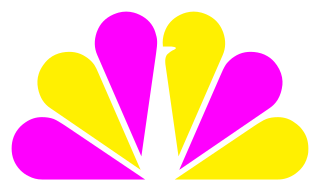 W
WThe Free Art and Technology Lab a.k.a. F.A.T. Lab was a collective of artists, engineers, scientists, lawyers, and musicians, dedicated to the merging of popular culture with open source technology. F.A.T. Lab was known for producing artwork critical of traditional Intellectual Property Law in the realm of new media art and technology. F.A.T. Lab has historically created work intended for the public domain, but has also released work under various open licenses. Their commitment is to support "open values and the public domain through the use of emerging open licenses, support for open entrepreneurship and the admonishment of secrecy, copyright monopolies and patents. F.A.T. Lab's mission has been approached through various methods of placing open ideals into the mainstream popular culture, including work with the New York Times, MTV, the front page of YouTube and in the Museum of Modern Art permanent collection."
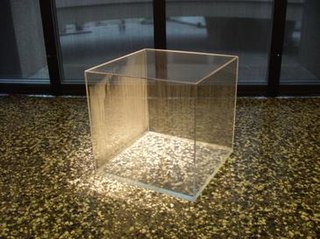 W
WGenerative art refers to art that in whole or in part has been created with the use of an autonomous system. An autonomous system in this context is generally one that is non-human and can independently determine features of an artwork that would otherwise require decisions made directly by the artist. In some cases the human creator may claim that the generative system represents their own artistic idea, and in others that the system takes on the role of the creator.
 W
WGlitch art is the practice of using digital or analog errors for aesthetic purposes by either corrupting digital data or physically manipulating electronic devices. Glitches appear in visual art such as the film A Colour Box (1935) by Len Lye, the video sculpture TV Magnet (1965) by Nam June Paik and more contemporary work such as Panasonic TH-42PWD8UK Plasma Screen Burn (2007) by Cory Arcangel.
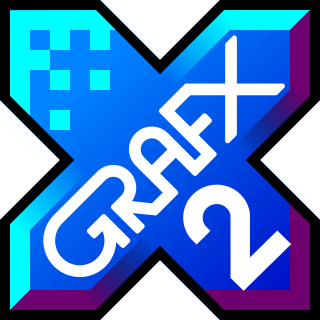 W
WGrafX2 is a bitmap graphics editor inspired by the Amiga programs Deluxe Paint and Brilliance. It is free software and distributed under GNU General Public License.
 W
WGraphic art software is a subclass of application software used for graphic design, multimedia development, stylized image development, technical illustration, general image editing, or simply to access graphic files. Art software uses either raster or vector graphic reading and editing methods to create, edit, and view art.
 W
WComputer-generated imagery (CGI) is the application of computer graphics to create or contribute to images in art, printed media, video games, films, television programs, shorts, commercials, videos, and simulators. The images may be dynamic or static, and may be two-dimensional (2D), although the term "CGI" is most commonly used to refer to the 3-D computer graphics used for creating characters, scenes and special effects in films and television, which is described as 'CGI animation'.
 W
WThe imai Foundation was founded in 2006 as imai - inter media art institute. It is an institution dedicated to the preservation, research and distribution of video art and media art and associated activities. The foundation organizes workshops, conferences, screenings, exhibitions, research projects and case studies concerning the current questions of conservation and restoration of media art. It aims to develop further the possibilities of (digital) preservation, presentation and distribution of media art.
 W
WUnlike traditional mosaics which rely on differently colored material arranged in arbitrary configurations to make an image, impressionist mosaics are created using the natural flaws and marbling in the tiles to create the impression of an image. Depending on the definition, this may be limited to arranging square, homogeneously colored tiles in a grid-like, non-overlapped fashion.
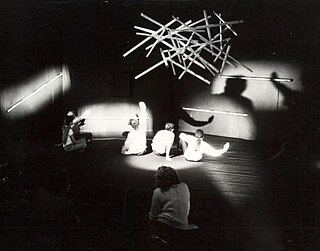 W
WInteractive art is a form of art that involves the spectator in a way that allows the art to achieve its purpose. Some interactive art installations achieve this by letting the observer or visitor "walk" in, on, and around them; some others ask the artist or the spectators to become part of the artwork.
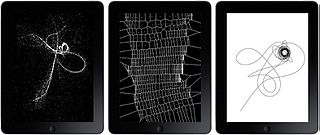 W
WiPhone art is a form of Interactive art that takes place on the screen of the iPhone, iPad, or iPod Touch. It is distinct from pictorial works of art produced with an iPhone using paint apps such as Brushes or ArtRage.
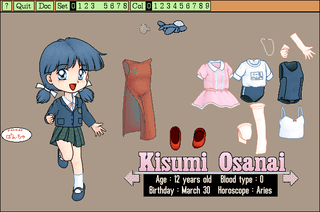 W
WKisekae Set System is a blending of art with computers originally designed to allow creation of virtual "paper dolls". Kisekae is short for "kisekae ningyou"; a Japanese term meaning "dress-up dolls". Unlike "computer art" which creates or displays traditional art via a computer, KiSS uses the computer as the medium, allowing the art to be not only animated, but also interactive.
 W
WCatherine Mason is an art historian and author who specialises in digital art, especially computer art.
 W
WMilkDrop is a hardware-accelerated music visualization plugin for Winamp, which was originally developed by Ryan Geiss in 2001. It uses DirectX and intelligent beat detection to render iterated images which blend seamlessly. MilkDrop uses a complex system of interpolation to transition between presets gradually through time, creating a constantly changing visual experience.
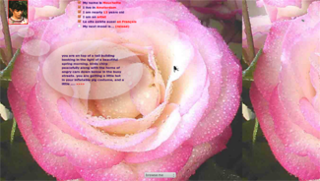 W
WMouchette.org is an interactive website created in 1996 by a pseudonymous character, an Amsterdam-based artist who calls herself "Mouchette". With her innocent salutation and claims to be "nearly thirteen" greeting the visitor from the introduction page, what initially appears as a personal website of an underage female artist evolves into darker themes in the subsequent pages.
 W
WNEAT Particles is an Interactive evolutionary computation program that enables users to evolve particle systems intended for use as special effects in video games or movie graphics. Rather than being hand-coded like typical particle systems, the behaviors of NEAT Particle effects are evolved by user preference. Therefore, non-programmer, non-artist users may evolve complex and unique special effects in real time. NEAT Particles is meant to augment and assist the time-consuming computer graphics content generation process.
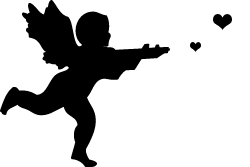 W
WNortd Labs a.k.a. NOR_/D is an international research and development collaborative dedicated to the merging of open source art, architecture, software and system design. NORTD Labs is also a studio of creative thought that engages science, art and design.
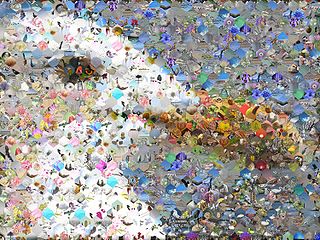 W
WIn the field of photographic imaging, a photographic mosaic, also known under the term Photomosaic, is a picture that has been divided into tiled sections, each of which is replaced with another photograph that matches the target photo. When viewed at low magnifications, the individual pixels appear as the primary image, while close examination reveals that the image is in fact made up of many hundreds or thousands of smaller images. Most of the time they are a computer-created type of montage.
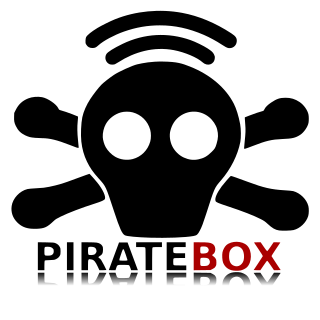 W
WA PirateBox is a portable electronic device, often consisting of a Wi-Fi router and a device for storing information, creating a wireless network that allows users who are connected to share files anonymously and locally. By design, this device is disconnected from the Internet.
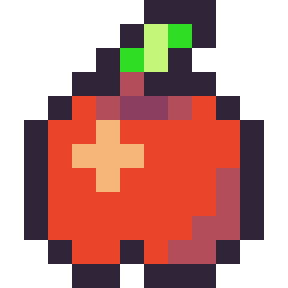 W
WPixel art is a form of digital art, created through the use of software, where images are edited on the pixel level. The aesthetic for this kind of graphics comes from 8-bit and 16-bit computers and video game consoles, in addition to other limited systems such as graphing calculators. In most pixel art, the color palette used is extremely limited in size, with some pixel art using only two colors.
Place was a collaborative project and social experiment hosted on the social networking site Reddit that began on April Fools' Day in 2017. The experiment involved an online canvas located at a subreddit called r/place, which registered users could edit by changing the color of a single pixel from a 16-colour palette. After each pixel was placed, a timer prevented the user from placing any pixels for a period of time varying from 5 to 20 minutes.
 W
WA scenery generator is software used to create landscape images, 3D models, and animations. These programs often use procedural generation to generate the landscapes. If not using procedural generation to create the landscapes, then normally a 3D artist would render and create the landscapes. These programs are often used in video games or movies. Basic elements of landscapes created by scenery generators include terrain, water, foliage, and clouds. The process for basic random generation uses a diamond square algorithm.
 W
WSynth is an action real-time strategy video game by Canadian developer Rhys Paul Hovey for Microsoft Windows. Synth is an abstract and procedurally generated 3D game, in which the graphics have an algorithmic C++ representation.
 W
WUltra Fractal is a fractal generation and rendering software application. The program was the first publicly available fractal software which featured layering methods previously only found in image editing software. Because of this the program has become popular for use in the creation of fractal art.
 W
WUnfolding Object is a 2002 work of internet art created by John Simon after a commission from the Solomon R. Guggenheim Museum in New York City. Along with net.flag by Mark Napier, it was among the first pieces of internet art to be collected by a major museum.
 W
WUpStage is an open source server-side application that has been purpose built for Cyberformance: multiple artists collaborate in real time via the UpStage platform to create and present live theatrical performances, for audiences who can be online or in a shared space, and who can interact with the performance via a text chat tool. It can also be understood as a form of digital puppetry. It is the first open source platform designed specifically for avatar performances.
 W
WA USB dead drop is a USB mass storage device installed in a public space. For example, a USB flash drive might be mounted in an outdoor brick wall and fixed in place with fast concrete. Members of the public are implicitly invited to find files, or leave files, on a dead drop by directly plugging their laptop into the wall-mounted USB stick in order to transfer data. The dead drops can therefore be regarded as an anonymous, offline, peer-to-peer file sharing network. However, in practice USB dead drops are often used for social or artistic reasons, rather than for practical ones.